Chapter: 11th 12th std standard Class Physics sciense Higher secondary school College Notes
End-on (or) Tan A position- Deflection magnetometer
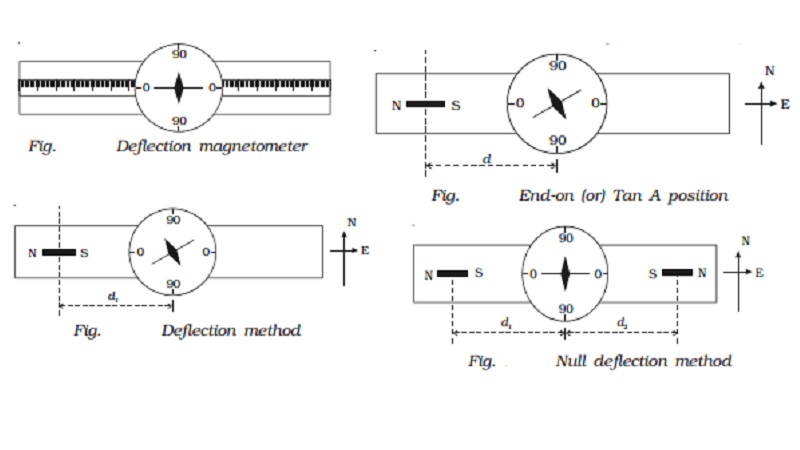
Deflection magnetometer
Deflection magnetometer consists
of a small magnetic needle pivoted on a sharp support such that it is free to
rotate in a horizontal plane. A light, thin, long aluminium pointer is fixed
perpendicular to the magnetic needle. The pointer also rotates along with the
needle (Fig.).
There
is a circular scale divided into four quadrants and each quadrant is graduated
from 0o to 90o. A plane mirror fixed below the scale
ensures, reading without parallax error, as the image of the pointer is made to coincide
exactly with pointer itself. The needle, aluminium pointer and the scale are
enclosed in a box with a glass top. There are two arms graduated in centimetre
and their zeroes coincide at the centre of the magnetic needle.
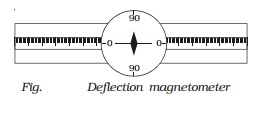
End-on (or) Tan A position- Deflection magnetometer
The magnetic field at a point
along the axial line of a bar magnet is perpendicular to the horizontal
component of Earth?s magnetic field. If a magnetometer and a bar magnet are
placed in such way that this condition is satisfied, then this arrangement is
called Tan A position.
To achieve this, the arms of the
deflection magnetometer are placed along East-West direction (i.e) perpendicular to the magnetic meridian. The
bar magnet is placed along East - West direction (i.e) parallel to the arms, as
shown in the Fig.
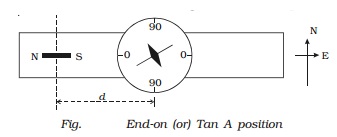
When a bar magnet of magnetic
moment M and length 2l is placed at a
distance d from the centre of the
magnetic needle, the needle gets deflected through an angle ? due to the action of two magnetic fields.
(i) the field B due to the bar magnet
acting along its axis and
(ii) the horizontal component of
Earth?s magnetic field Bh.
The magnetic field at a distance d acting along the axial line of the bar
magnet,
B = ?0/ 4 π . 2 Md/(d2-l2) 2
According to Tangent law,
B = Bh tan θ
?0/ 4 π . 2 Md/(d2-l2) 2
= Bh tan θ
(i) Deflection method
The deflection magnetometer is
placed in Tan A position (Fig.). A bar magnet of magnetic moment M1 and length 2l1 is placed at a distance d1 from the centre of the magnetic needle, on one side of the compass
box. Since, the sensitivity of the
magnetometer is more at 45o, the distance of the bar magnet should
be chosen such that the deflection lies between 30o and 60o.
The readings corresponding to the ends of the aluminium pointer are noted as θ 1 and θ 2. The magnet is reversed pole to
pole and kept at the same distance. Two more readings θ3 and θ4 are noted. By placing the magnet
on the other side of the compass box at the same distance, four more readings θ 5, θ 6, θ 7 and θ 8 are noted as above. The mean of
the eight readings gives a value θI.
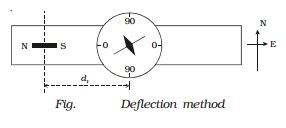
The experiment is repeated as
above for the second bar magnet of magnetic moment M2 and length 2l 2 by placing at a
distance d2. Now the
mean of the eight readings gives a value of θII.
Applying tangent law, for the
first magnet,
?0/4 π . 2M1d1/(d12-l12)2
= Bhtan θI ?????.(1)
and for the second magnet.
?0/4 π . 2M2d2/(d22-l22)2
= Bhtan θII ?????.(2)
From the above equations (1) and
(2), we get
M1/M2 = [ (d12 ? l12)2 tan
θI ] / [ (d22
? l22)2
tan θII ]
Special case
If the magnets are placed at the
same distance, then d1 = d2 = d
M1/M2 = [ (d12 ? l12)2 tan
θI ] / [ (d22
? l22)2
tan θII ]
In addition, if l1 and
l2 are small compared to the distance d
Then M1/M2
= tan θI / tan θI
(ii) Null deflection method
The deflection magnetometer is
placed in Tan A position (Fig.). A bar magnet of magnetic moment M1 and length
2l1 is placed on one side
of the compass
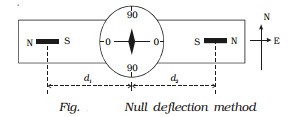
The experiment is repeated by
interchanging the magnets. Two more distances x3 and x4
are noted. The mean of x1,
x2, x3 and x4
is taken as d2.
As the magnetic fields due to the
two bar magnets at the centre of the magnetic needle are equal in magnitude but
opposite in direction,
(i.e) B1 = B2
M1/M2 = [ (d12 ? l12)2 d2
] / [ (d22 ?
l22)2
d1 ]
If the bar magnets are short, l1 and l2 are negligible compared to the distance d1
and d2
M1/M2 = d13
/ d23
Related Topics